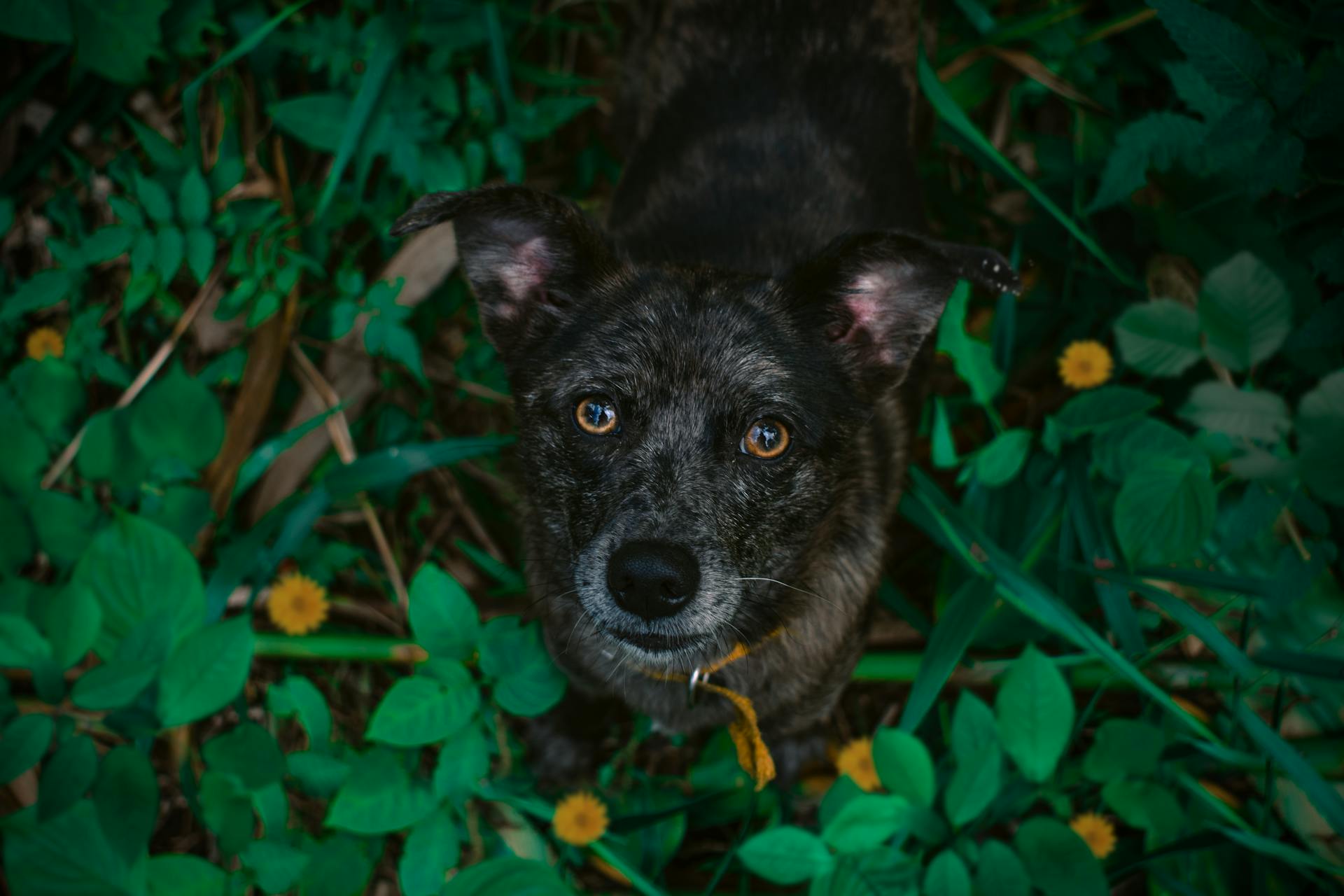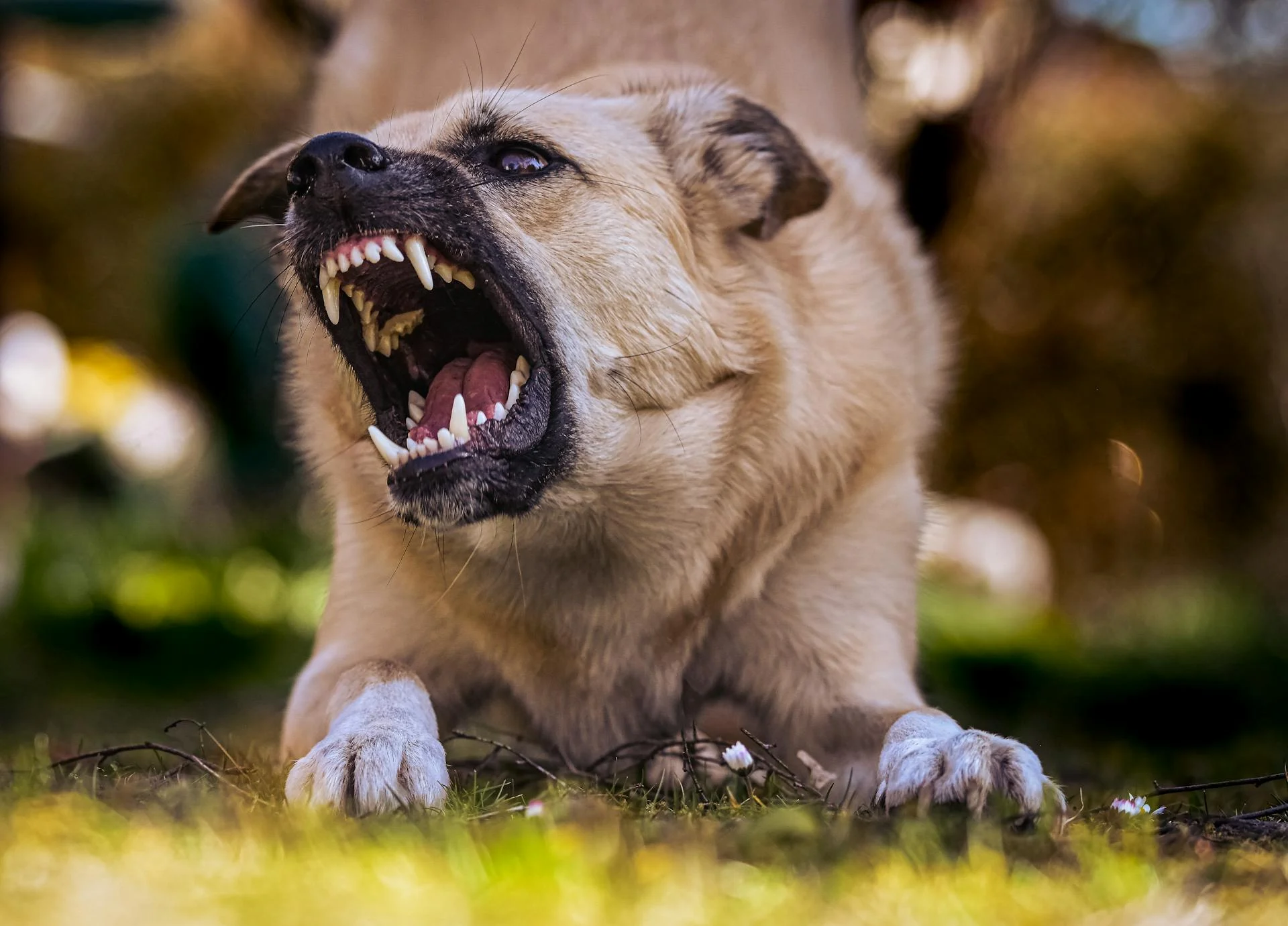
Dog growling at a familiar person can be a concerning and confusing behavior. A dog's growl is often a warning sign that they feel threatened, scared, or need space.
According to research, dogs may growl at familiar people due to a lack of socialization or training. This can lead to fear-based aggression, which is a common issue in many households.
If your dog is growling at a familiar person, it's essential to identify the underlying cause of the behavior. Is your dog feeling anxious or territorial? Are there any changes in their environment that may be contributing to the growling?
Understanding the root cause of your dog's growling will help you develop an effective plan to address the behavior.
Check this out: Growling Doberman Pinscher
Causes of Growling
Growling can be a warning sign that a dog is feeling threatened, scared, or in pain. A perceived threat or challenge, such as a sudden movement or loud noise, can trigger a dog's instinct to defend itself.
Reinforcement of aggression is a common cause of growling, especially if a dog's growling leads to the desired outcome, like avoiding a situation or gaining control. This creates a reinforcement loop that makes the behavior more likely to recur.
In some cases, a dog's growling can be a result of fear aggression, which can arise from a lack of socialisation during the puppy stage or traumatic experiences. Even a gentle touch or a familiar person can be perceived as a threat if a dog has had a negative experience in the past.
Some common stimuli that can trigger a fear-based aggressive reaction in dogs, leading to growling, include:
- Strangers reaching toward their head
- Another dog or a person making direct eye contact
- Having their nails trimmed
- Having their ears plucked
- Having their ears cleaned
- Being bathed
- Being shaved
- Being approached or petted when they are lying down
- Being hugged
- Getting a needle injection
- Being restrained by a stranger
- Having their fur grabbed
- Being touched in a sensitive area, such as their tail, paws, or belly
Causes of Pain-Induced
Causes of Pain-Induced Aggression can be a real challenge to understand. Dogs suffering from health conditions like orthopaedic pain, infections, or other ailments may react aggressively, particularly when handled or touched.
Some training equipment can also cause pain and lead to pain-induced aggression. Certain tools, like pinch collars or shock collars, can be particularly problematic.

It's essential to choose training methods and equipment that prioritize the dog's comfort and well-being to prevent such responses. This can make a huge difference in a dog's behavior and overall happiness.
Health conditions can be unpredictable, and it's crucial to be aware of the signs of pain-induced aggression. Orthopaedic painInfectionsOther health ailments can all contribute to a dog's aggressive behavior.
By understanding these causes, we can take steps to prevent pain-induced aggression and create a more harmonious relationship with our furry friends.
Common Frustration Triggers
Physical restraint can be a major frustration trigger for dogs, causing them to bite at their lead, hand, or collar when they're held back from a stimulus. This is because the dog is unable to engage with what it wants, leading to a buildup of frustration and aggression.
Confinement is another common trigger, where dogs associate restraint with frustration and may become aggressive in low-stimulus situations. For example, a friendly dog may become aggressive when placed behind a gate, in a cage or crate, confined in a car, or held back by a leash.
Broaden your view: Why Are Chihuahuas Aggressive

Some common triggers for frustration-elicited aggression include physical restraint and confinement. Here are some examples:
By recognizing these triggers, you can take steps to reduce your dog's frustration and prevent growling.
Common Triggers for Possessiveness
Some dogs become aggressive if a person or animal approaches while they are eating or comes near their food bowl, exhibiting aggressive behaviours like growling, snarling, or snapping to protect their resources.
Dogs may guard their food, toys, or other valuable items, showing aggression if someone tries to take them away.
Many dogs guard their chew bones, toys, or items they have taken, and may exhibit possessive aggression if someone attempts to take these objects away.
Some dogs show possessive aggression around their preferred resting spots, such as their crate, bed, or other areas where they feel secure.
Here are some common triggers for possessive aggression in dogs:
Common Triggers
Growing up with dogs, I've seen firsthand how certain triggers can set them off. A trigger is something that sets off a reaction, and for dogs, it can be as simple as a stranger reaching towards their head.
Some common triggers for growling include strangers making direct eye contact, which can be perceived as a threat. Another common trigger is having their nails trimmed, which can be a stressful experience for many dogs.
Dogs may also growl when they feel their personal space is being invaded, such as when someone approaches or pets them while they're lying down. This is a common situation that can be easily avoided.
Here are some common triggers for growling, grouped by category:
It's worth noting that each dog is different, and what triggers one dog's growling may not trigger another's. By understanding what triggers your dog's growling, you can take steps to avoid those situations and create a more peaceful environment for both you and your dog.
Behavior Signs and Types
Dogs often growl at familiar people due to various reasons, including resource guarding, fear, or territoriality.
Resource guarding can lead to possessive aggression, where a dog feels compelled to protect their belongings from others.
Fear aggression is more likely to result from a lack of socialization or past traumatic experiences.
Territorial aggression occurs when a person or animal enters a dog's claimed space, such as their sleeping area.
A dog's body language can indicate fear aggression, including turned ears, lip licking, panting, pacing, body tremors, direct eye contact, bristling hairs, avoidance behavior, and vocalizations like whining, barking, or growling.
Some common signs of protective behavior in dogs include an alert but calm stance, focus on the new person in their environment, being constantly vigilant, moving between you and the possible threat, growling or barking at actual threats, and returning to normal if there is no threat.
Dogs exhibiting protective aggression may hackles raised and body tense, immediately start barking, overreact to the situation, lunge and snap, bare their teeth at the perceived threat, and bite.
Here are some common types of aggression in dogs:
- Territorial aggression
- Protective aggression
- Possessive aggression
- Fear or defensive aggression
- Social aggression
- Frustration-elicited aggression
- Pain-elicited aggression
Each of these types of aggression can manifest differently, but understanding the underlying causes can help you address the issue and prevent future episodes.
Desensitization and Management
Desensitization is a key concept in helping your dog overcome growling at familiar people. It involves reducing the trigger to a level your dog doesn't react to, allowing them to exhibit good behavior.
To desensitize your dog, start by keeping them at a distance they are comfortable with, such as a few feet away. As time passes, you can gradually decrease the distance, increasing the chances of a positive interaction.
Desensitization is often paired with counterconditioning, which changes your dog's emotional response from negative to positive. This can be done by showering your dog with affection, treats, toys, or other rewards when they remain calm in the presence of the familiar person.
By following these steps, you can help your dog become more comfortable around familiar people and reduce growling incidents.
Here's a summary of the desensitization process:
Pain Management
Pain Management is a crucial aspect of desensitization and management. Regular veterinary check-ups can help catch and treat health issues that may cause pain, which in turn can reduce aggression.
Observing your dog's behavior is key to managing pain-induced aggression. Watch for signs of pain or discomfort, such as whining, limping, or sensitivity to touch.
Gentle handling is essential when dealing with a dog in pain. Approach with patience, care, and sensitivity to reduce the risk of an aggressive reaction.
By following these simple steps, you can help reduce your dog's pain and aggression.
Desensitization and Counterconditioning
Desensitization and Counterconditioning are powerful tools in managing your dog's behavior. Desensitization involves exposing your dog to a trigger at a level they can tolerate, then gradually increasing the intensity.
Desensitization works by reducing the trigger to a point where your dog no longer reacts. For example, if your dog reacts to others when walking, start by keeping them at a distance they're comfortable with. As time passes, your dog's threshold will change, allowing you to decrease the distance.
Counterconditioning changes your dog's emotional response from negative to positive. It's paired with desensitization and involves associating the trigger with something pleasant. For instance, if your dog reacts to others when on your lap, let them see the other person at a distance while showering them with affection, treats, or toys.
Additional reading: What Can You Feed Dogs Other than Dog Food
A consistent approach is key to successful desensitization and counterconditioning. By pairing these techniques with rewards and positive interactions, you can help your dog build trust and develop healthy behaviors.
Here are some key steps to keep in mind:
- Gradually increase the intensity of the trigger.
- Pair the trigger with something pleasant to change your dog's emotional response.
- Start with small steps and build up gradually.
- Be patient and consistent in your approach.
By applying these principles, you can help your dog become more confident and less reactive in the face of triggers. Remember to always reward good behavior and be patient with your dog as they learn and grow.
Addressing Resource Guarding
Addressing resource guarding requires a thoughtful and multi-step approach.
Identifying the triggers of your dog's guarding behavior is crucial to managing it effectively. Observe situations that trigger the behavior and take steps to manage them.
Gradual exposure to perceived threats around their resources can help desensitize your dog. Controlled exposure to these triggers, such as having multiple people near their food or toys, can help your dog become more comfortable with sharing.
For severe cases of resource guarding, it's best to seek assistance from a behaviourist. They can create a personalized plan to help your dog overcome this behaviour.
Here are some specific steps to take when addressing resource guarding:
- Identify Triggers: Observe situations that trigger the dog’s guarding behaviour to manage these effectively.
- Controlled Exposure: Gradually introduce training exercises that desensitise the dog to perceived threats around their resources.
- Professional Guidance: For severe cases, seek assistance from a behaviourist who can help create a personalised plan.
Sources
- https://www.dogster.com/dog-training/how-to-stop-dog-protective-aggression
- https://www.nylabone.com/dog101/dog-aggression-vs-playing
- https://cbtdogbehaviour.com/types-of-aggression-2/
- https://www.petmd.com/dog/behavior/fear-aggression-dogs
- https://petexpertise.com/blogs/news/dog-training-and-emotional-behavior
Featured Images: pexels.com


